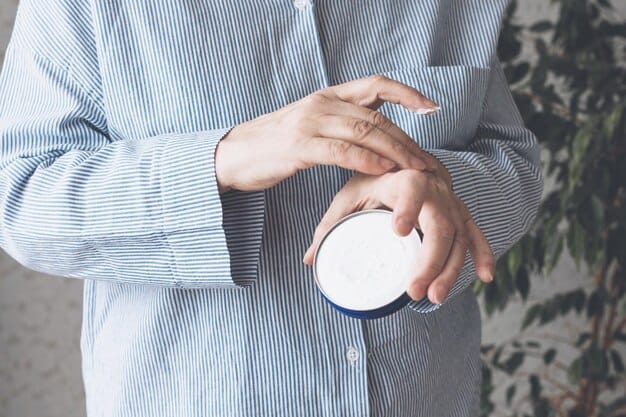Sensitive Skin Savior: Gentle Skincare for Redness Reduction

Sensitive Skin Savior: A Gentle Skincare Routine to Reduce Redness and Irritation by 20% focuses on calming inflammation and hydrating the skin with fragrance-free, hypoallergenic products for noticeable improvements.
Is your skin easily irritated, prone to redness, or reactive to certain ingredients? You might be experiencing sensitive skin. But don’t worry, achieving a calm, clear complexion is within reach. Discover the Sensitive Skin Savior: A Gentle Skincare Routine to Reduce Redness and Irritation by 20%, unveiling the secrets to soothing your skin and minimizing flare-ups.
Understanding Sensitive Skin
Sensitive skin isn’t a medical diagnosis, but rather a description of skin that’s more prone to inflammation or adverse reactions. It can manifest in various ways, from occasional redness to persistent itching and burning.
Several factors can contribute to skin sensitivity, including genetics, environmental stressors, and underlying skin conditions. Identifying your triggers is the first step toward managing sensitive skin.
Common Symptoms of Sensitive Skin
Recognizing the signs of sensitive skin is crucial for tailoring your skincare routine. Here are some common symptoms:
- Frequent redness or flushing
- Itching or burning sensations
- Dryness and flakiness
- Reactions to fragrances, dyes, or certain ingredients
Identifying Your Sensitive Skin Triggers
Pinpointing your specific triggers can help you avoid products and environmental factors that irritate your skin. Consider keeping a skincare journal to track your reactions.
Common triggers include:
- Harsh soaps and detergents
- Fragrances and artificial dyes
- Certain skincare ingredients like alcohol and sulfates
- Sun exposure
A gentle skincare routine is a valuable approach to help you reduce skin’s redness and irritation helping you reach your skin goals.

Building a Gentle Skincare Routine
When it comes to sensitive skin, simplicity is key. A streamlined routine with gentle, fragrance-free products can make a world of difference.
Look for products specifically formulated for sensitive skin, and always patch-test new products before applying them to your entire face.
The Core Components of a Sensitive Skincare Routine
A basic sensitive skincare routine typically includes these steps:
- Cleansing: Use a gentle, sulfate-free cleanser to remove dirt and oil without stripping the skin.
- Moisturizing: Hydrate the skin with a fragrance-free moisturizer to replenish moisture and protect the skin barrier.
- Sunscreen: Apply a broad-spectrum sunscreen with an SPF of 30 or higher every day to protect against sun damage.
Choosing the Right Products
Navigating the skincare aisle can be overwhelming, especially with sensitive skin. Here are some ingredients to look for and avoid:
- Look for: Ceramides, hyaluronic acid, and niacinamide, which can help strengthen the skin barrier and reduce inflammation.
- Avoid: Alcohol, fragrances, sulfates, and harsh exfoliants, which can irritate the skin.
Sensitive skin requires a careful balance of ingredients and gentle application techniques. This detailed guide can help you better maintain a healthy skin barrier.
Cleansing for Sensitive Skin
Cleansing is an essential step in any skincare routine, but it’s especially important for sensitive skin. Harsh cleansers can strip the skin of its natural oils, leading to dryness and irritation.
Opt for a gentle, sulfate-free cleanser that effectively removes dirt and oil without disrupting the skin’s delicate balance. Look for ingredients like chamomile extract, which has soothing properties.
Choosing a Gentle Cleanser
When selecting a cleanser for sensitive skin, consider these factors:
- Sulfate-free: Sulfates are harsh detergents that can strip the skin of its natural oils.
- Fragrance-free: Fragrances are a common trigger for sensitive skin.
- pH-balanced: A pH-balanced cleanser helps maintain the skin’s natural acidity.
Proper Cleansing Technique for Sensitive Skin
The way you cleanse your skin can be just as important as the products you use. Follow these tips for gentle cleansing:
- Use lukewarm water: Hot water can dry out the skin.
- Apply cleanser with your fingertips: Avoid using washcloths or sponges, which can be abrasive.
- Pat skin dry: Avoid rubbing the skin, which can cause irritation.
With the correct tools and approach, cleansing can be both effective and soothing, setting the stage for the rest of your delicate skincare routine.
Moisturizing Sensitive Skin
Moisturizing is crucial for maintaining a healthy skin barrier and preventing dryness and irritation. A good moisturizer helps hydrate the skin and lock in moisture.
Look for a fragrance-free moisturizer with ingredients like ceramides and hyaluronic acid, which can help strengthen the skin barrier and attract moisture to the skin.
Key Ingredients in Moisturizers
Here are some beneficial ingredients to look for in a moisturizer for sensitive skin:
- Ceramides: Help strengthen the skin barrier and prevent moisture loss.
- Hyaluronic acid: Attracts moisture to the skin, providing hydration.
- Niacinamide: Reduces inflammation and improves the skin barrier function.
Applying Moisturizer for Optimal Results
To maximize the benefits of your moisturizer, apply it to damp skin after cleansing. This helps lock in moisture and keep your skin hydrated throughout the day.
The Importance of a Healthy Skin Barrier
Your skin barrier is the outermost layer of your skin, responsible for protecting against environmental aggressors and preventing water loss. When the skin barrier is compromised, it can lead to dryness, irritation, and increased sensitivity.
Moisturizing helps support and maintain a healthy skin barrier, reducing the risk of flare-ups and improving the overall health of your skin.
Regular moisturizing supports and maintains a healthy skin barrier, ultimately reducing the risk of flare-ups and promoting healthier-looking skin.

Sun Protection for Sensitive Skin
Sun exposure is a major trigger for sensitive skin, leading to redness, inflammation, and even sunburn. Protecting your skin from the sun is essential for preventing flare-ups and maintaining healthy skin.
Choose a broad-spectrum sunscreen with an SPF of 30 or higher, and apply it liberally to all exposed skin. Look for mineral sunscreens with zinc oxide or titanium dioxide, which are generally less irritating than chemical sunscreens.
Choosing the Right Sunscreen
When selecting a sunscreen for sensitive skin, consider these factors:
- Mineral-based: Mineral sunscreens are less likely to cause irritation.
- Fragrance-free: Fragrances can irritate sensitive skin.
- Broad-spectrum: Protects against both UVA and UVB rays.
Application Tips for Sunscreen
Apply sunscreen at least 15 minutes before sun exposure, and reapply every two hours, or more often if swimming or sweating. Don’t forget to protect often-missed areas like your ears, neck, and the tops of your feet.
Sun avoidance is another important aspect of sun protection for sensitive skin. Seek shade during peak sun hours (10 a.m. to 4 p.m.), and wear protective clothing like hats and sunglasses.
With the right sun protection habits, you can enjoy the outdoors without exacerbating your skin sensitivity.
Lifestyle Adjustments for Sensitive Skin
In addition to a gentle skincare routine, certain lifestyle adjustments can help manage sensitive skin and reduce the risk of flare-ups.
These adjustments include managing stress, staying hydrated, and avoiding harsh environmental factors.
Managing Stress
Stress can exacerbate skin sensitivity, leading to redness, itching, and other symptoms. Finding healthy ways to manage stress, such as exercise, meditation, or spending time in nature, can help improve your skin’s overall health.
Staying Hydrated
Dehydration can lead to dry, irritated skin. Drinking plenty of water helps keep your skin hydrated from the inside out, improving its overall health and resilience.
Avoiding Harsh Environmental Factors
Exposure to harsh environmental factors like cold weather, wind, and pollution can irritate sensitive skin. Protect your skin by wearing protective clothing, using a humidifier, and avoiding prolonged exposure to these elements.
By managing stress, staying hydrated, and making conscious decisions about environmental exposure, you can create a lifestyle that supports calm, healthy skin.
Tracking Progress and Adjusting Your Routine
Managing sensitive skin is an ongoing process that requires patience and attention. Tracking your progress and adjusting your routine as needed can help you achieve long-term results.
Keep a skincare journal to track your reactions to different products and lifestyle adjustments. This will help you identify patterns and make informed decisions about your routine.
###Monitoring Your Skin’s Reaction
With the correct products coupled with time, you’ll want to ensure your skin is not reactive to your current products.
- Redness levels
- Dryness and flakiness
- Itching and burning
If a product appears to have no effect on your skin for worse or for better, consider eliminating it entirely. There may be an irritant at play in that product which isn’t easy to spot initially.
Consistency is key when managing sensitive skin. Stick to your routine as much as possible, even when your skin is looking and feeling good. This will help maintain a healthy skin barrier and prevent future flare-ups.
By carefully curating your products and routine, you’ll be well on your way to reduced redness and skin irritation.
| Key Point | Brief Description |
|---|---|
| ✨ Gentle Cleansing | Use sulfate-free, fragrance-free cleansers to avoid stripping natural oils. |
| 💧 Hydrating Moisturizers | Apply moisturizers with ceramides and hyaluronic acid to strengthen the skin barrier. |
| ☀️ Mineral Sunscreen | Protect skin with mineral-based sunscreens (zinc oxide/titanium dioxide) and avoid harsh chemicals. |
| 🌱 Lifestyle Adjustments | Manage stress, stay hydrated, and avoid harsh environmental factors to improve skin health. |
Frequently Asked Questions
▼
Sensitive skin isn’t a medical diagnosis but refers to skin that’s easily irritated, reactive, or prone to inflammation. Symptoms include redness, itching, dryness, and reactions to common irritants.
▼
Cleanse your sensitive skin gently once or twice daily. Over-cleansing can strip the skin of its natural oils, leading to dryness and irritation. Focus on gentle, sulfate-free formulas.
▼
Fragrances are a common trigger for sensitive skin, so it’s generally best to avoid them. Look for products labeled “fragrance-free” rather than “unscented” as the latter may still contain masking fragrances.
▼
Yes, diet can play a role. Certain foods, like dairy or highly processed items, might worsen inflammation. Staying hydrated and eating an anti-inflammatory diet rich in fruits and vegetables can help support skin health.
▼
Improvements vary, however most see notable changes in the range of 4-8 weeks. Consistency with a gentle skincare routine, avoiding triggers, and making lifestyle adjustments generally yield results.
Conclusion
Managing sensitive skin requires understanding your triggers, building a gentle skincare routine, and making lifestyle adjustments. By prioritizing gentle cleansing, moisturizing, sun protection, and stress management, you can reduce redness and irritation, resulting in a healthier, more comfortable complexion, to achieve the Sensitive Skin Savior: A Gentle Skincare Routine to Reduce Redness and Irritation by 20%.





